Fabrication of Polyurethane/Laponite/Graphene Transparent Coatings with High Surface Hardness
Abstract
:1. Introduction
2. Material and Methods
2.1. Materials
2.2. Preparation of Lap-GO Dispersion
2.3. Preparation of Polyurethane Nanocomposite Solution
2.4. Preparation of Polyurethane/Laponite/Graphene Transparent Coatings with High Surface Hardness
2.5. Test Characterization Methods
3. Results and Discussion
3.1. XRD Analysis of Lap-GO Dispersion
3.2. FT-IR Analysis of Lap-GO Dispersion
3.3. Selection of Mass Ratio of Lap-GO Dispersion
3.4. AFM Analysis of Lap-GO Dispersion
3.5. Analysis of Coating Microstructure
3.6. Analysis of Coating Hardness
3.7. Analysis of Coating Transmittance
3.8. Analysis of Coating WCA
3.9. Analysis of Coating Water and Alcohol Resistance
4. Conclusions
Author Contributions
Funding
Institutional Review Board Statement
Informed Consent Statement
Data Availability Statement
Conflicts of Interest
References
- Kausar, A. Polyurethane nanocomposite coatings: State of the art and perspectives. Polym. Int. 2018, 67, 1470–1477. [Google Scholar] [CrossRef]
- Carreño, F.; Gude, M.R.; Calvo, S.; de la Fuente, R.O.; Carmona, N. Design and development of icephobic coatings based on sol-gel/modified polyurethane paints. Mater. Today Commun. 2020, 25, 101616. [Google Scholar] [CrossRef]
- Ou, B.L.; Chen, M.L.; Guo, Y.J.; Kang, Y.H.; Guo, Y.; Zhang, S.G.; Yan, J.H.; Liu, Q.Q.; Li, D.X. Preparation of novel marine antifouling polyurethane coating materials. Polym. Bull. 2018, 75, 5143–5162. [Google Scholar] [CrossRef]
- Golling, F.E.; Pires, R.; Hecking, A.; Weikard, J.; Richter, F.; Danielmeier, K.; Dijkstra, D. Polyurethanes for coatings and adhesives–chemistry and applications. Polym. Int. 2018, 68, 848–855. [Google Scholar] [CrossRef]
- Fan, W.W.; Wang, J.C.; Li, Z.J. Antiglare waterborne polyurethane/modified silica nanocomposite with balanced comprehensive properties. Polym. Test. 2021, 99, 107072. [Google Scholar] [CrossRef]
- Kong, L.L.; Xu, D.D.; He, Z.X.; Wang, F.Q.; Gui, S.H.; Fan, J.L.; Pan, X.Y.; Dai, X.H.; Dong, X.Y.; Liu, B.X.; et al. Nanocellulose-Reinforced Polyurethane for Waterborne Wood Coating. Molecules 2019, 24, 3151. [Google Scholar] [CrossRef] [PubMed]
- Nikolic, M.; Lawther, J.M.; Sanadi, A.R. Use of nanofillers in wood coatings: A scientific review. J. Coat. Technol. Res. 2015, 12, 445–461. [Google Scholar] [CrossRef]
- Cheng, D.; Wen, Y.B.; An, X.Y.; Zhu, X.H.; Ni, Y.H. TEMPO-oxidized cellulose nanofibers (TOCNs) as a green reinforcement for waterborne polyurethane coating (WPU) on wood. Carbohydr. Polym. 2016, 151, 326–334. [Google Scholar] [CrossRef]
- Xia, W.J.; Zhu, N.Q.; Hou, R.J.; Zhong, W.G.; Chen, M.Q. Preparation and Characterization of Fluorinated Hydrophobic UV-Crosslinkable Thiol-Ene Polyurethane Coatings. Coatings 2017, 7, 117. [Google Scholar] [CrossRef]
- Xu, D.D.; Liang, G.T.; Qi, Y.R.; Gong, R.Z.; Zhang, X.Q.; Zhang, Y.M.; Liu, B.X.; Kong, L.L.; Dong, X.Y.; Li, Y.F. Enhancing the Mechanical Properties of Waterborne Polyurethane Paint by Graphene Oxide for Wood Products. Polymer 2022, 14, 5456. [Google Scholar] [CrossRef]
- Re, G.; Croce, A.; D’Angelo, D.; Marchese, L.; Rinaudo, C.; Gatti, G. Application of nano-coating technology for the protection of natural lapideous materials. Surf. Coat. Technol. 2022, 441, 128507. [Google Scholar] [CrossRef]
- Fu, J.C.; Wang, L.; Yu, H.L.; Haroon, M.; Haq, F.; Shi, W.; Wu, B.; Wang, L.B. Research progress of UV-curable polyurethane acrylate-based hardening coatings. Prog. Org. Coat. 2019, 131, 82–99. [Google Scholar] [CrossRef]
- Mohanty, S.R.; Mohanty, S.; Samal, S.K.; Nayak, S.K. Acrylic-ester-polyol based novel two-component polyurethane clear coat: Evaluation of performance characteristics. J. Appl. Polym. Sci. 2021, 138, 50794. [Google Scholar] [CrossRef]
- Ma, X.Y.; Zhang, M.R. Preparation and Properties of Graphene Oxide-Modified Anti-UV Waterborne Polyurethane Nanocomposites. Nano 2020, 15, 2050005. [Google Scholar] [CrossRef]
- Wang, J.; Dai, D.; Xie, H.; Li, D.; Xiong, G.; Zhang, C. Biological Effects, Applications and Design Strategies of Medical Polyurethanes Modified by Nanomaterials. Int. J. Nanomed. 2022, 17, 6791–6819. [Google Scholar] [CrossRef]
- Tiwari, S.K.; Sahoo, S.; Wang, N.; Huczko, A. Graphene research and their outputs: Status and prospect. J. Sci. Adv. Mater. Devices 2020, 5, 10–29. [Google Scholar] [CrossRef]
- Abdel Ghany, N.A.; Elsherif, S.A.; Handal, H.T. Revolution of Graphene for different applications: State-of-the-art. Surf. Interfaces 2017, 9, 93–106. [Google Scholar] [CrossRef]
- Mason, M.J.; Coleman, B.J.; Saha, S.; Mustafa, M.M.; Green, M.J. Graphene signatures: Identifying graphite and Graphene grades via radio frequency heating. Carbon 2021, 182, 564–570. [Google Scholar] [CrossRef]
- Palermo, V.; Kinloch, I.A.; Ligi, S.; Pugno, N.M. Nanoscale Mechanics of Graphene and Graphene Oxide in Composites: A Scientific and Technological Perspective. Adv. Mater. 2016, 28, 6232–6238. [Google Scholar] [CrossRef]
- Vishnyakova, E.; Chen, G.; Brinson, B.E.; Alemany, L.B.; Billups, W.E. Structural Studies of HydroGraphenes. Acc. Chem. Res. 2017, 50, 1351–1358. [Google Scholar] [CrossRef]
- Ma, Q.; Lui, C.H.; Song, J.C.W.; Lin, Y.; Kong, J.F.; Cao, Y.; Dinh, T.H.; Nair, N.L.; Fang, W.; Watanabe, K.; et al. Giant Intrinsic Photoresponse in Pristine Graphene. Nat. Nanotechnol. 2019, 14, 145–150. [Google Scholar] [CrossRef] [PubMed]
- Li, Y.; Yang, Z.; Qiu, H.; Dai, Y.; Zheng, Q.; Li, J.; Yang, J. Self-Aligned Graphene as Anticorrosive Barrier in Waterborne Polyurethane Composite Coatings. J. Mater. Chem. A 2014, 2, 14139–14145. [Google Scholar] [CrossRef]
- Peng, S.; Iroh, J.O. Synthesis and Characterization of Crosslinked Polyurethane/Clay Nanocomposites. J. Appl. Polym. Sci. 2016, 133, 43346. [Google Scholar] [CrossRef]
- Cidonio, G.; Alcala-Orozco, C.R.; Lim, K.S.; Glinka, M.; Mutreja, I.; Kim, Y.-H.; Dawson, J.I.; Woodfield, T.B.F.; Oreffo, R.O.C. Osteogenic and Angiogenic Tissue Formation in High Fidelity Nanocomposite Laponite-Gelatin Bioinks. Biofabrication 2019, 11, 035027. [Google Scholar] [CrossRef] [PubMed]
- Liff, S.M.; Kumar, N.; McKinley, G.H. High-Performance Elastomeric Nanocomposites via Solvent-Exchange Processing. Nat. Mater. 2007, 6, 76–83. [Google Scholar] [CrossRef]
- Choi, H.Y.; Bae, C.Y.; Kim, B.K. Nanoclay Reinforced UV Curable Waterborne Polyurethane Hybrids. Prog. Org. Coat. 2010, 68, 356–362. [Google Scholar] [CrossRef]
- Rahman, M.M.; Kim, H.; Lee, W. Preparation and Characterization of Waterborne Polyurethane/Clay Nanocomposite: Effect on Water Vapor Permeability. J. Appl. Polym. Sci. 2008, 110, 3697–3705. [Google Scholar] [CrossRef]
- Fan, X.; Peng, W.; Li, Y.; Li, X.; Wang, S.; Zhang, G.; Zhang, F. Deoxygenation of Exfoliated Graphite Oxide under Alkaline Conditions: A Green Route to Graphene Preparation. Adv. Mater. 2008, 20, 4490–4493. [Google Scholar] [CrossRef]
- Jin, M.; He, W.; Wang, C.; Yu, F.; Yang, W. Covalent Modification of Graphene Oxide and Applications in Polystyrene Composites. React. Funct. Polym. 2020, 146, 104437. [Google Scholar] [CrossRef]
- Turgut, F.; Chong, C.Y.; Karaman, M.; Lau, W.J.; Gürsoy, M.; Ismail, A.F. Plasma Surface Modification of Graphene Oxide Nanosheets for the Synthesis of GO/PES Nanocomposite Ultrafiltration Membrane for Enhanced Oily Separation. J. Appl. Polym. Sci. 2023, 140, e53410. [Google Scholar] [CrossRef]
- Mishra, A.K.; Chattophadyay, S.; Nando, G.B.; Devadoss, E. Synthesis and Characterization of Elastomeric Polyurethane-Laponite Nanocomposite. Des. Monomers Polym. 2008, 11, 395–407. [Google Scholar] [CrossRef]
- Li, J.; Jiang, Z.; Gan, L.; Qiu, H.; Yang, G.; Yang, J. Functionalized Graphene/Polymer Composite Coatings for Autonomous Early-Warning of Steel Corrosion. Compos. Commun. 2018, 9, 6–10. [Google Scholar] [CrossRef]
- Chouhan, D.K.; Patro, T.U.; Harikrishnan, G.; Kumar, S.; Gupta, S.; Kumar, G.S.; Cohen, H.; Wagner, H.D. Graphene Oxide-Laponite Hybrid from Highly Stable Aqueous Dispersion. Appl. Clay Sci. 2016, 132, 105–113. [Google Scholar] [CrossRef]
- Zhang, Y.; Hu, J. Isocyanate Modified GO Shape-Memory Polyurethane Composite. Polymers 2020, 12, 118. [Google Scholar] [CrossRef] [PubMed]
- GB/T9271-2008; National Coatings and Pigments Standardization Technical Committee. Colorpaint and Varnish, Standard Test Board. China Standards Press: Beijing, China, 2008. (In Chinese)
- GB/T6739-2006; National Coatings and Pigments Standardization Technical Committee. Colorpaintand Varnish, Determination of Pencil Hardness by Pencil Method. China Standards Press: Beijing, China, 2006. (In Chinese)
- GB/T30693-2014; Examination Methods for Key Products of Quality Super-Vision, Measurement of Water Contact Angle of Plastic Film. China Standards Press: Beijing, China, 2015. (In Chinese)
- GB/T4893.1-2021; State Administration for Market Regulation and Standardization Administration of the People’s Republic of China. Test of Surface Coatings of Furniture—Part 1: Determination of Surface Resistance to Cold Liquids. China Standards Press: Beijing, China, 2021. (In Chinese)
- Yoo, J.; Lee, S.B.; Lee, C.K.; Hwang, S.W.; Kim, C.; Fujigaya, T.; Nakashima, N.; Shim, J.K. Graphene Oxide and Laponite Composite Films with High Oxygen-Barrier Properties. Nanoscale 2014, 6, 10824. [Google Scholar] [CrossRef]
- Hernandez, Y.; Nicolosi, V.; Lotya, M.; Blighe, F.M.; Sun, Z.; De, S.; McGovern, I.T.; Holland, B.; Byrne, M.; Gun’Ko, Y.K.; et al. High-Yield Production of Graphene by Liquid-Phase Exfoliation of Graphite. Nat. Nanotechnol. 2008, 3, 563–568. [Google Scholar] [CrossRef]
- Alhassan, S.M.; Qutubuddin, S.; Schiraldi, D.A. Graphene Arrested in Laponite–Water Colloidal Glass. Langmuir 2012, 28, 4009–4015. [Google Scholar] [CrossRef]
- Ding, S.-N.; Zheng, C.-L.; Wan, N.; Cosnier, S. Graphene/Clay Composite Electrode Formed by Exfoliating Graphite with Laponite for Simultaneous Determination of Ascorbic Acid, Dopamine, and Uric Acid. Monatshefte Chem. Chem. Mon. 2014, 145, 1389–1394. [Google Scholar] [CrossRef]
- Wu, W.; Dong, Z.; He, J.; Yu, J.; Zhang, J. Transparent Cellulose/Laponite Nanocomposite Films. J. Mater. Sci. 2016, 51, 4125–4133. [Google Scholar] [CrossRef]
- Li, J.; Cui, J.; Yang, Z.; Qiu, H.; Tang, Z.; Yang, J. Stabilizing Graphene Layers by Intercalating Laponite between Them. New Carbon Mater. 2018, 33, 19–25. [Google Scholar] [CrossRef]
- Domene-López, D.; Sarabia-Riquelme, R.; García-Quesada, J.C.; Martin-Gullon, I. Custom-Made Chemically Modified Graphene Oxide to Improve the Anti-Scratch Resistance of Urethane-Acrylate Transparent Coatings. Coatings 2019, 9, 408. [Google Scholar] [CrossRef]
- Shin, S.; Hwang, B.; Zhao, Z.-J.; Jeon, S.H.; Jung, J.; Lee, J.-H.; Ju, B.-K.; Jeong, J.-H. Transparent Displays Utilizing Nanopatterned Quantum Dot Films. Sci. Rep. 2018, 8, 2463. [Google Scholar] [CrossRef] [PubMed]
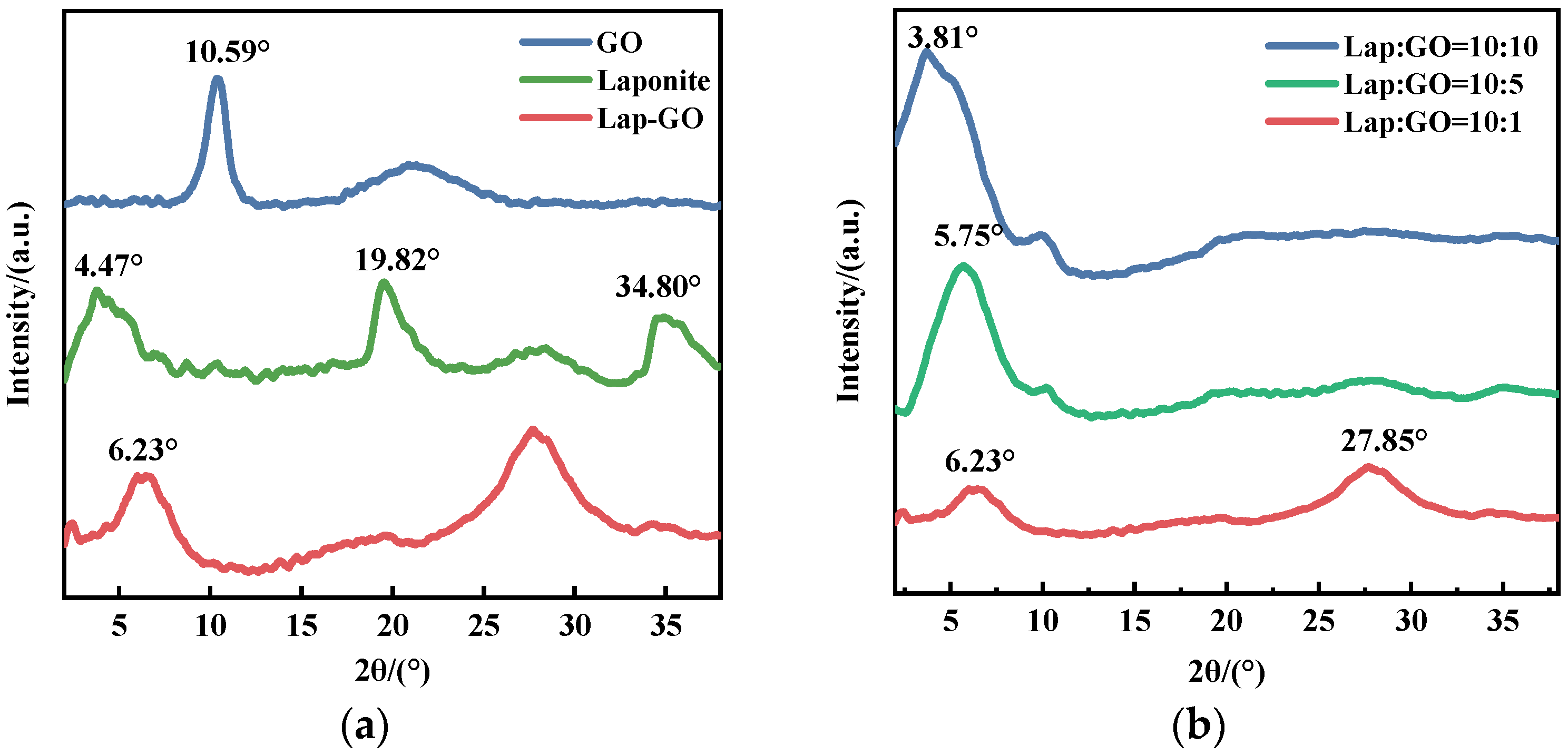
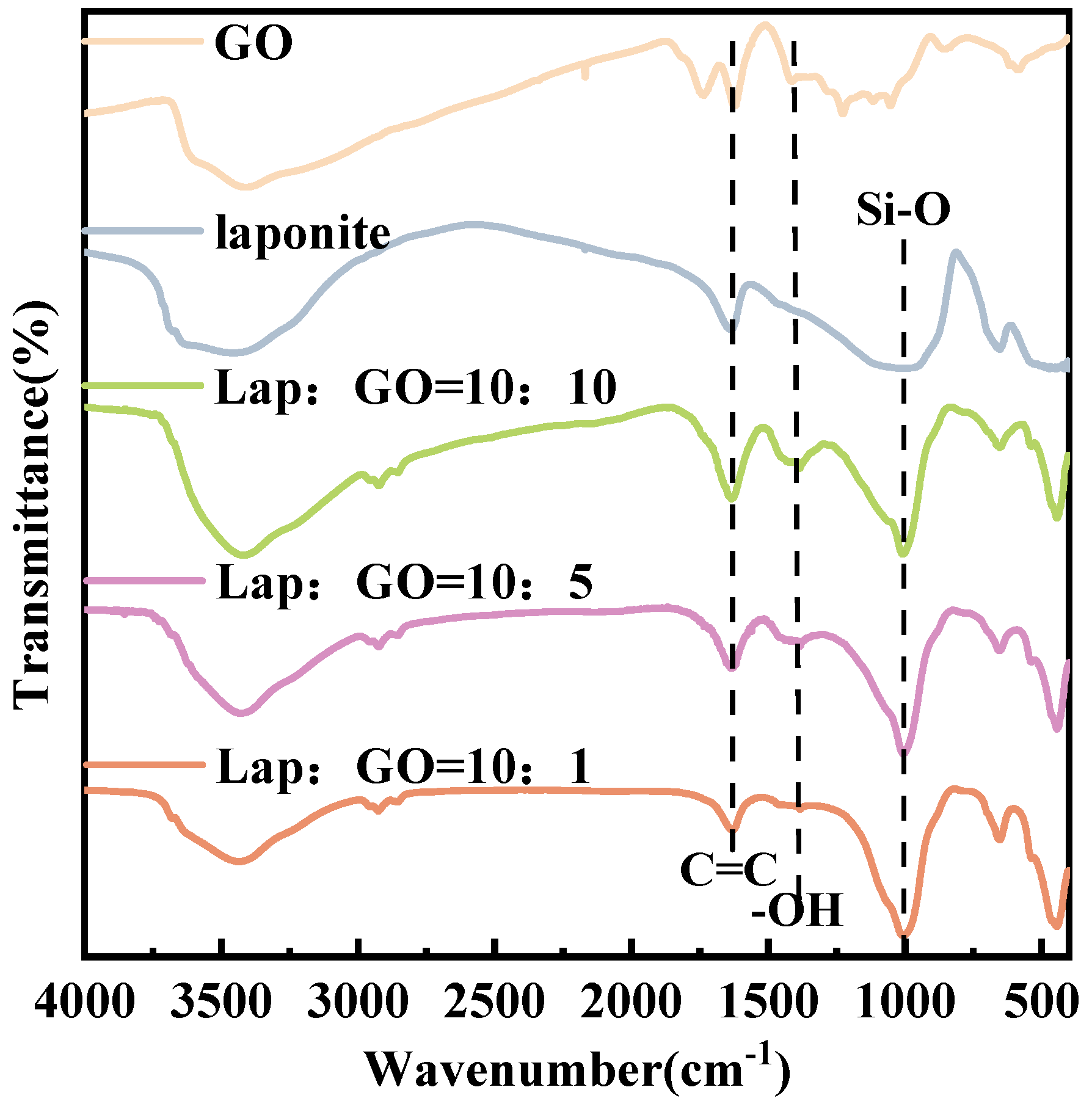
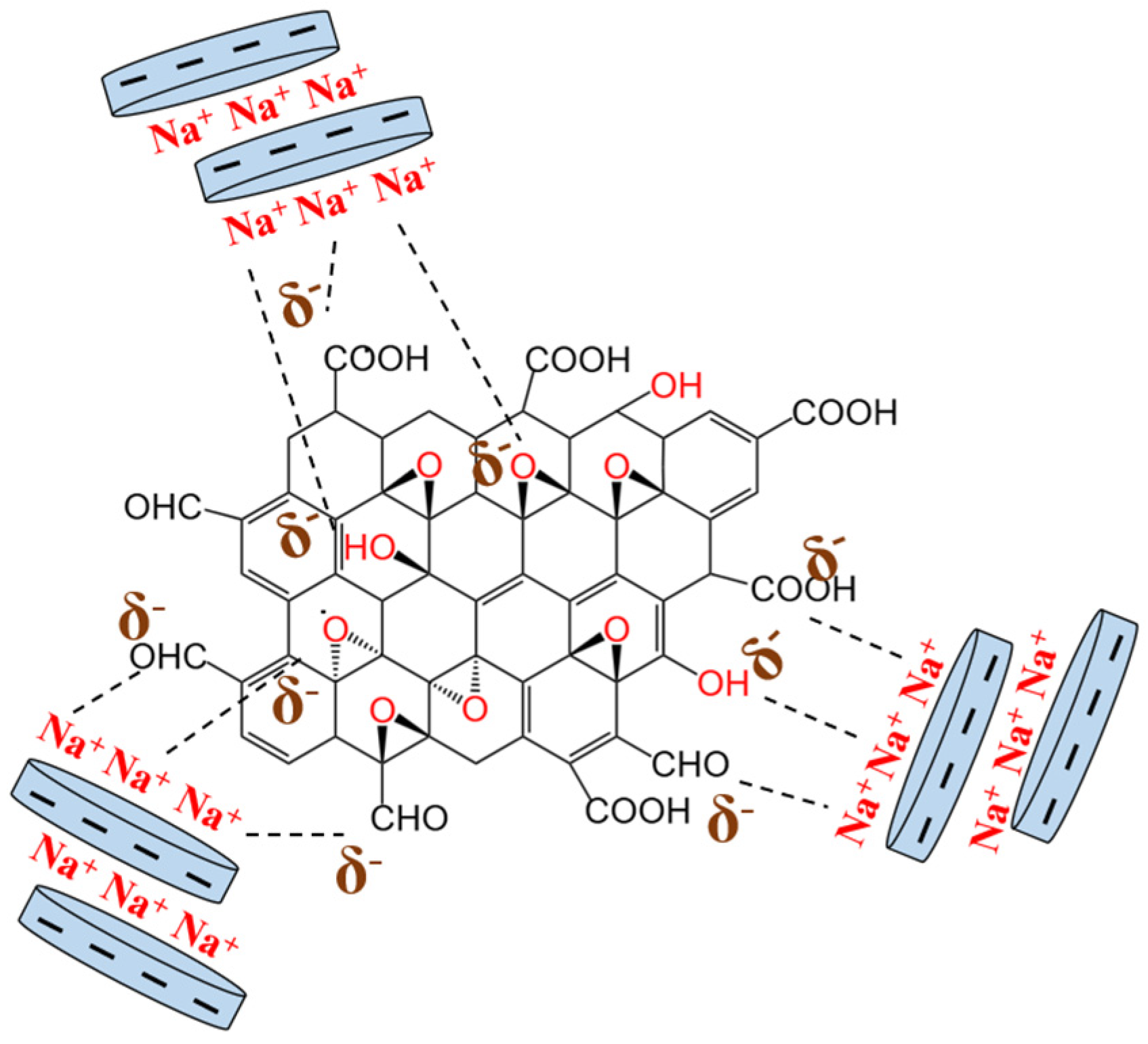

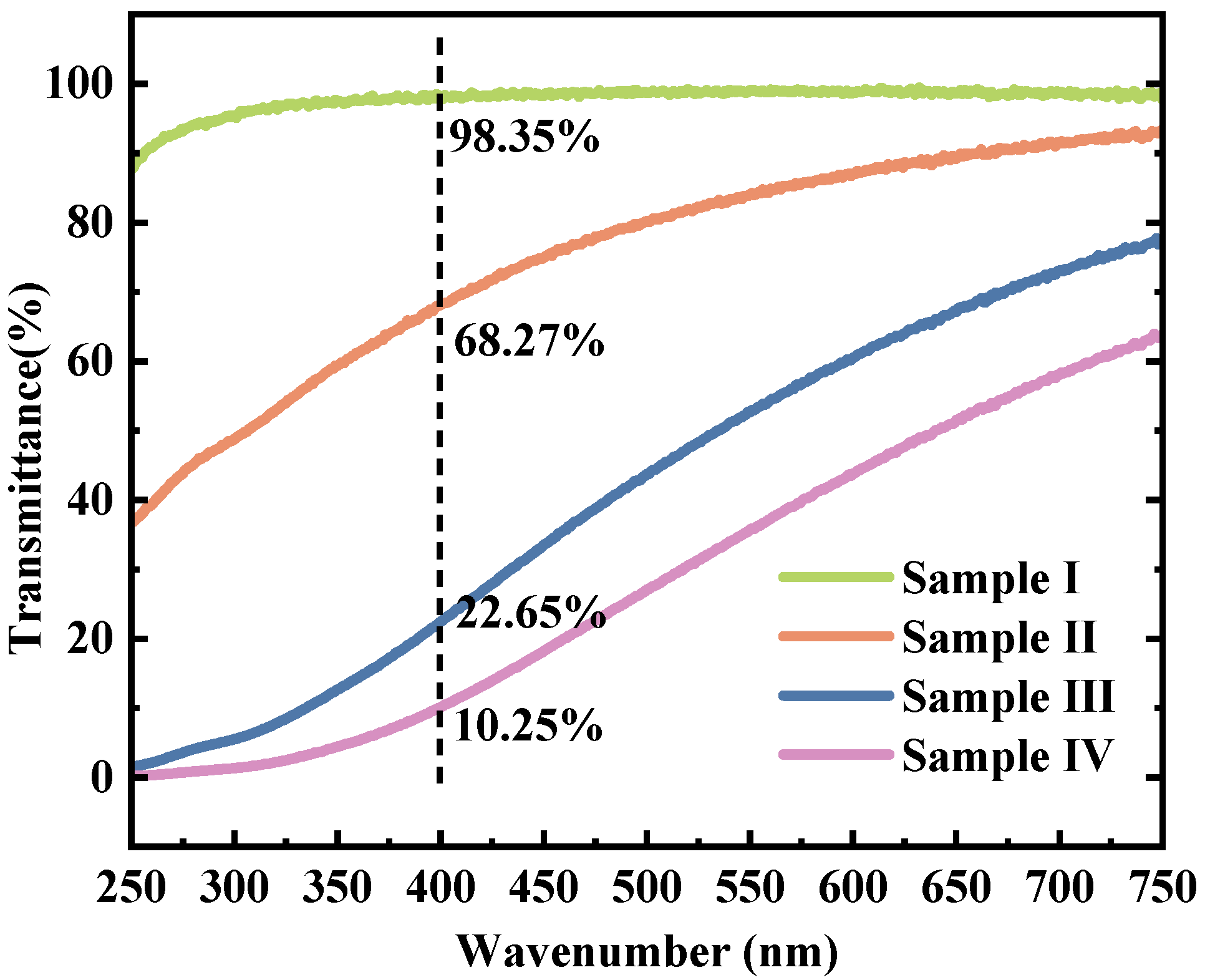
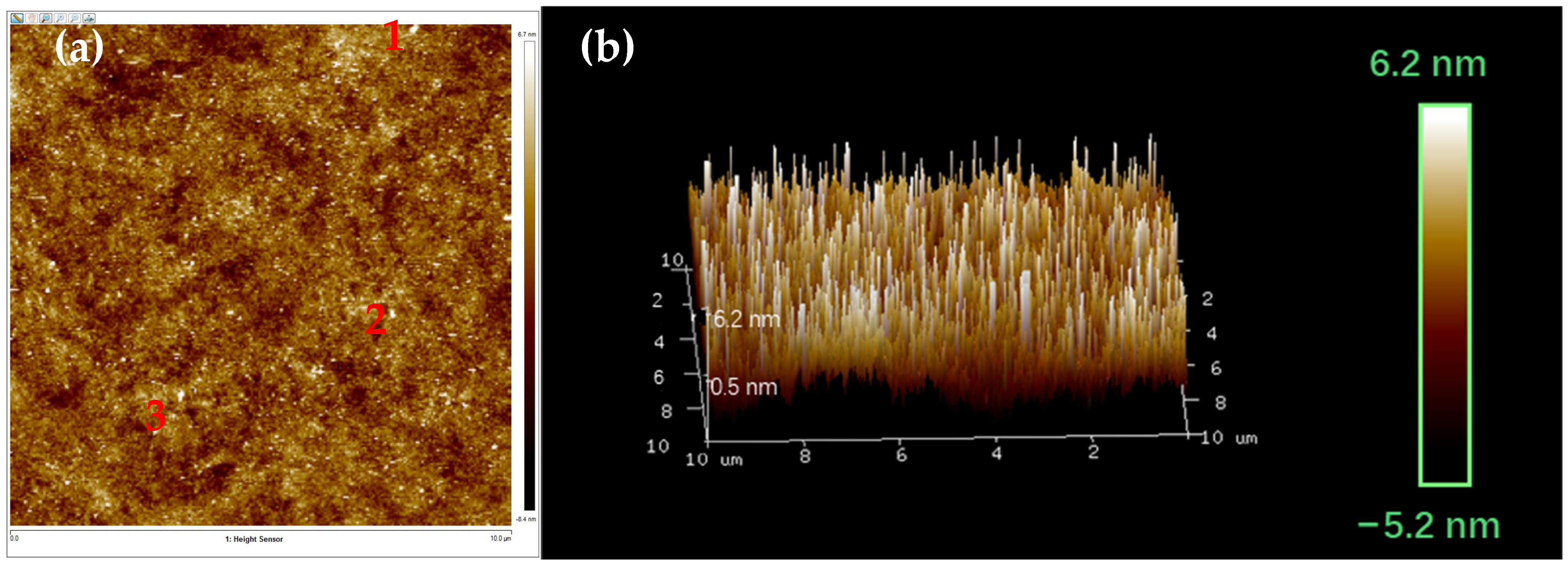


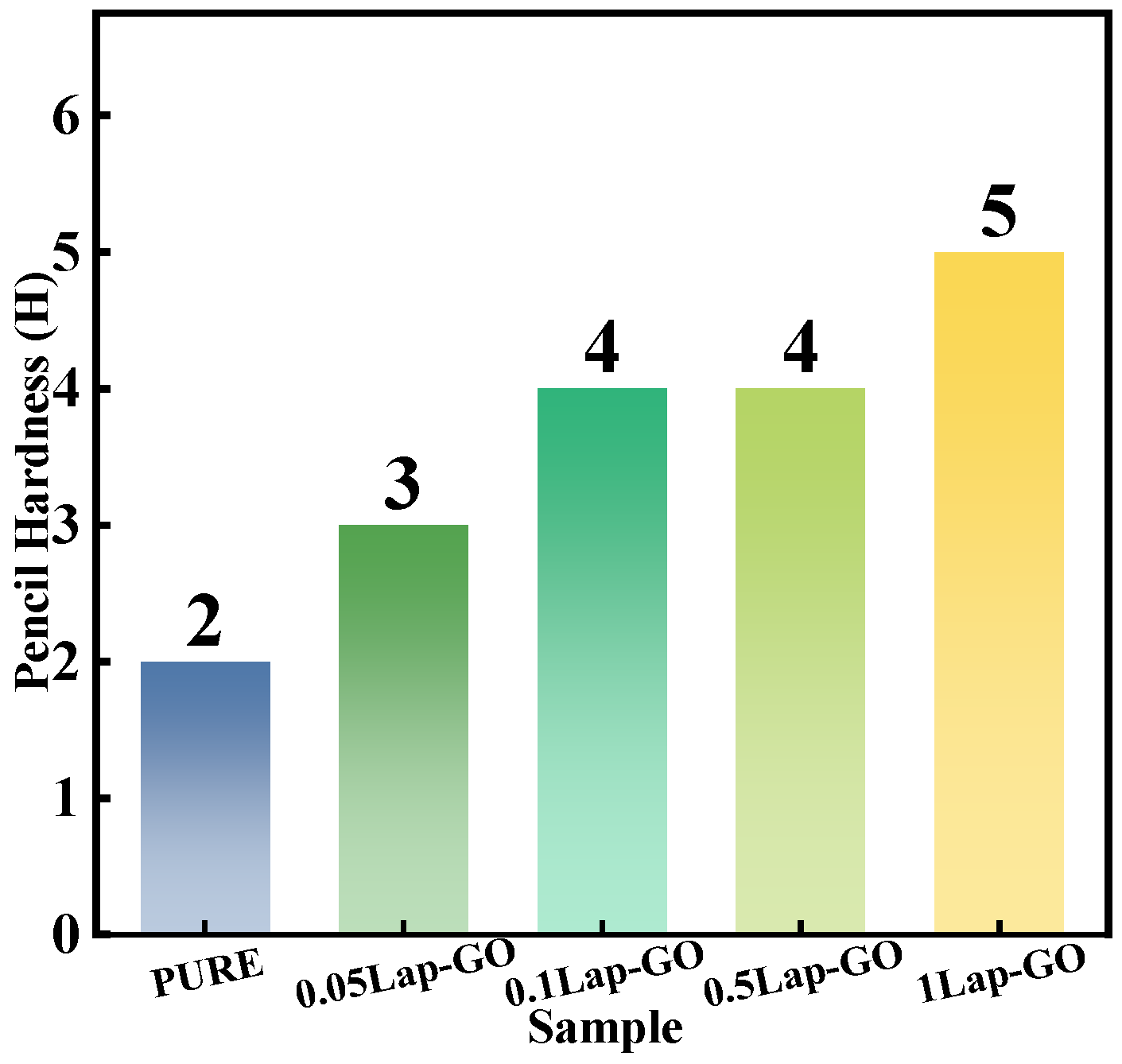





| Sample | Lap-GO Contents/wt‰ |
|---|---|
| 0.05Lap-GO | 0.05 |
| 0.1Lap-GO | 0.10 |
| 0.5Lap-GO | 0.50 |
| 1Lap-GO | 1.00 |
| Pair | Horizontal Distance (nm) | Vertical Distance (nm) | Surface Distance (nm) |
|---|---|---|---|
| 1 | 118 | 10.944 | 119 |
| 2 | 275 | 11.286 | 275 |
| 3 | 157 | 10.016 | 158 |
| PURE | 0.05Lap-GO | 0.1Lap-GO | 0.5Lap-GO | 1Lap-GO | |
|---|---|---|---|---|---|
| 22,706.80 | 20,887.24 | 19,296.35 | 18,186.66 | 16,006.37 | |
| 100.00 | 91.99 | 84.98 | 80.09 | 70.49 | |
| for UV10 min | 98.73 | 89.15 | 80.23 | 71.27 | 62.98 |
Disclaimer/Publisher’s Note: The statements, opinions and data contained in all publications are solely those of the individual author(s) and contributor(s) and not of MDPI and/or the editor(s). MDPI and/or the editor(s) disclaim responsibility for any injury to people or property resulting from any ideas, methods, instructions or products referred to in the content. |
© 2023 by the authors. Licensee MDPI, Basel, Switzerland. This article is an open access article distributed under the terms and conditions of the Creative Commons Attribution (CC BY) license (https://creativecommons.org/licenses/by/4.0/).
Share and Cite
Jiao, T.; Shui, L.; Lin, M.; Huang, W.; Chen, G. Fabrication of Polyurethane/Laponite/Graphene Transparent Coatings with High Surface Hardness. Coatings 2024, 14, 12. https://doi.org/10.3390/coatings14010012
Jiao T, Shui L, Lin M, Huang W, Chen G. Fabrication of Polyurethane/Laponite/Graphene Transparent Coatings with High Surface Hardness. Coatings. 2024; 14(1):12. https://doi.org/10.3390/coatings14010012
Chicago/Turabian StyleJiao, Tianqi, Linyi Shui, Ming Lin, Wenhao Huang, and Guohua Chen. 2024. "Fabrication of Polyurethane/Laponite/Graphene Transparent Coatings with High Surface Hardness" Coatings 14, no. 1: 12. https://doi.org/10.3390/coatings14010012
APA StyleJiao, T., Shui, L., Lin, M., Huang, W., & Chen, G. (2024). Fabrication of Polyurethane/Laponite/Graphene Transparent Coatings with High Surface Hardness. Coatings, 14(1), 12. https://doi.org/10.3390/coatings14010012







